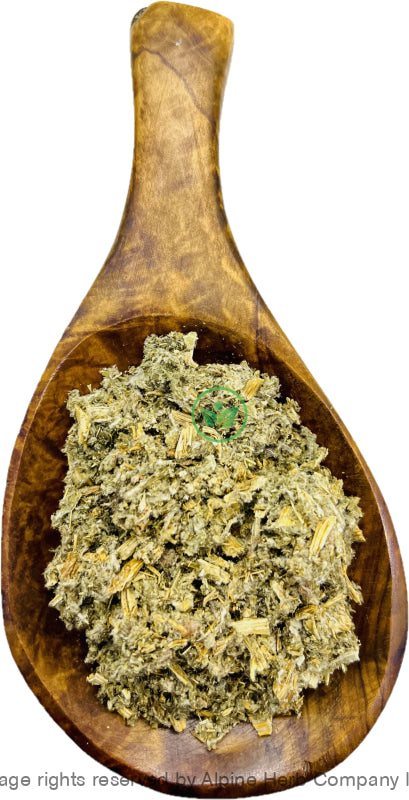Artichoke Leaves Cut Alpine Herb Company Inc.
$ 10,99 $ 6,59
Botanical Name: Cynara scolymus
Common Name:
- English: Globe artichoke
- Also, known as: Alcachofa, Alcaucil, ALE, Artichaut, Artichaut Commun, Artichoke Extract, Artichoke Fruit, Artichoke Leaf, Artichoke Leaf Extract, Artischocke, Cardo, Cardo de Comer, Cardon d’Espagne, Cardoon, Cynara, Cynara cardunculus, Cynara scolymus, Garden Artichoke, Gemuseartischocke, Globe Artichoke, Kardone, Tyosen-Azami, Wild Egyptian Artichoke
Origin: Hungary
Harvested: Wild
Parts Used: Leaves
General Information:
At first glance, Artichoke might seem like a strange thing to include in an herb and spice, but Artichoke has long been used as food and medicine. They are among the most antioxidant vegetables available. As lovely as the Artichoke vegetable is, this section is specifically about the leaves. What we typically eat (and see at the grocery store) is the flower bud. Artichoke leaves are lower down on the plant. The herbalist has long used bitter artichoke leaves for different health conditions. New research has been validating these uses and highlighting artichoke leaves. The globe artichoke also has a tuberous root but is the larger flower buds that from the edible portion of the plant, and it is from a similarity in the flavor of the tuber of the Jerusalem artichoke. It is one of the world’s oldest cultivated vegetables, grown by the Greeks and the Romans in the heyday of their power. It was introduced into these countries in the early sixteenth century both as a vegetable and an ornamental plant.
One of the secrets to artichoke leaf’s benefits lies in its bitter taste. How can it teste be good for digestion? The bitter taste is challenging. It is not only provoking our taste buds but also stimulates our entire digestive systems. Our bodies recognize the bitter teste as being potentially poisonous. As a result, when bitterness is detected our system goes into full alert and digestive juices start flowing to mitigate any poison entering our system. When you taste bitter foods and herbs regularly, your system is revved up and ready to go. Without this strong flavor, digestion can become sluggish and slow. In other words, we need bitterness daily to have good digestion.
How to use:
Hot Infusion:
The basic method for dried herbs and flower is, take 2-3 tablespoons of dried herb in a cup or teapot. Pour hot water over it and cover it with lid for 10-30 minutes. Hot water is needed to draw out the antioxidants, enzymes, vitamins, flavonoids, and volatile oils from the botanicals. Strain and squeeze out as much as liquid as possible and enjoy!
Tips:
- You can sweeten your herbal tea with bit of honey, natural fruit juice, stevia leaves powder and or licorice root powder.
- You can make ice cubes or pops by freezing tea in ice tray or pop molds.
Precautions:
You should consult with a qualified healthcare practitioner before using any herbal products, particularly if you are pregnant, nursing, or on any medications.
All information on this website is for educational purpose ONLY
This information has not been evaluated by Health Canada.
This information is not intended to diagnose, treat, cure, or prevent any disease.
| Unit Size | 100g, 200g, 400g, 1kg |
|---|
Prompt shipping and expert packing
Thanks to our longstanding association with UPS FedEx DHL as well as other leading global carriers, we can offer a variety shipping options. Our warehouse staff is highly trained and will be able to pack your goods in accordance with our precise and exact specifications. Your items will go through an exhaustive examination before they will be securely packaged before being delivered. We ship to hundreds of thousands of customers daily in different countries. This is a sign of our determination to become the largest online retailer worldwide. Warehouses and distribution centers are located throughout Europe as well as in the USA.
Note that orders containing multiple items are processed according to the particular item.
We will thoroughly inspect all items ordered before shipping. Most orders are shipped within 48 hours. The delivery time will be between 3 and 7 working days.
Returns
The stock market is always changing. It's not entirely managed by us since we're involved with several entities, including the factory and the storage. Therefore, the actual inventory could fluctuate at any moment. Please be aware that it is possible that your order could be out of stock after you've placed your order.
Our policy lasts for 30 days. If it's been more than 30 days since the date you purchased your item We're sorry to say that we can't offer you a full exchange or refund.
You can only return a product if it is unused and still in the same state as when you received it. The item should be in the original packaging.


































